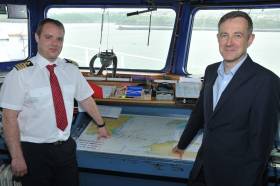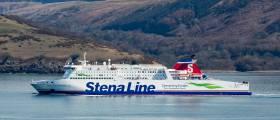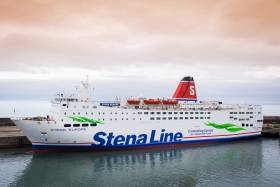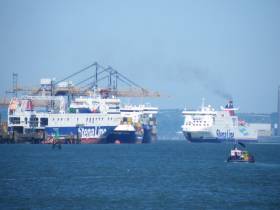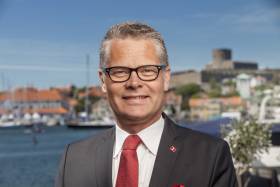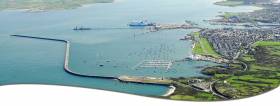Displaying items by tag: Stena Line
‘Best Ferry Company’ As Stena Line Win for 25th Time
#ferryaward - After winning a top ferry company award, Stena Line celebrated a record-breaking 25th time at the annual Northern Ireland Travel and Tourism Awards.
The ‘Best Ferry Company’ award was presented to Paul Grant, Stena Line’s Trade Director, Irish Sea North (ISN) at the awards ceremony last Friday at the Slieve Donard Resort and Spa in Newcastle, Co Down.
Northern Ireland Travel News has organised these prestigious awards for the past 26 years and this year’s ceremony was hosted by BBC's Pointless presenter Alexander Armstrong. The ceremony was attended by more than 430 guests and travel industry VIPs from all over the UK and Ireland.
Almost 30 awards were presented on the night, decided by votes from the travelling public, the travel trade, and by travel and tourism industry leaders.
Orla Noonan, Stena Line’s Travel Commercial Manager (ISN) said: “It’s an honour for Stena Line to receive this prestigious award coming as it does from our peers across the travel industry.
“Although this is our 25th consecutive year of winning the award we take absolutely nothing for granted and realise that each year we have to work even harder to provide our customers with a service which really is ‘award winning’.
“Whilst the travel industry is constantly changing and reinventing itself in an increasingly digital world, putting the needs of the customer first, every time, still remains the key objective for our business success, “added Orla.
Stena Line is the largest ferry operator on the Irish Sea, offering the biggest fleet and the widest choice of routes between Ireland to Britain including Belfast to Liverpool and Heysham, Belfast to Cairnryan, Dublin to Holyhead and Rosslare to Fishguard routes, a total of 228 weekly sailing options between Ireland and Britain.
In addition the ferry operator has a direct service from Rosslare to Cherbourg with three return crossings a week. Approximately three million passengers each year are carried on its Irish Sea routes, more than its rival ferry operators combined.
Freight Ferry Network on Stena North Sea UK-Rotterdam to Increase Capacity
#ferry- Stena Line which also operates a UK landbridge route network on the North Sea to mainland Europe, announced earlier this year an increase in its freight capacity on the Harwich-Rotterdam-Europoort route by replacing the current two RoRo vessels with two larger ships.
The ferry company has now confirmed plans to also increase capacity on the Killingholme-Rotterdam route in January 2018. Consequently this will increase its total capacity through Europoort by approximately 20%.
A decision has been taken to introduce a larger RoRo vessel on the North Sea to replace the current chartered ship, Caroline Russ, when its contract expires in January 2018.
Next year Stena Line will also reposition the RoRo ships between the Europoort routes to further optimise the available capacity. On the Killingholme-Rotterdam route, which was started with one vessel in 2014 and which has daily departures since 2016, MV Misida and MV Misana will operate. The new ship will be introduced on the Harwich-Rotterdam route in January 2018 and join former Irish Sea freightferry, Stena Scotia.
Annika Hult, Trade Director at Stena Line North Sea commented: “I am very pleased to announce that we will now take the next step in the strategic development of our Rotterdam (Europoort) Freight transport hub to the UK. We have seen a strong growth in the transport market to the UK over the past several years and we are currently trading at very high utilisation on both routes. We also see a good development in Freight volumes arriving to Europoort by train. We believe that the combination of rail and RoRo transportation will increase in the future and our vision is that Europoort will develop into a key rail freight connection point to and from the UK. These capacity increases clearly demonstrate our ambitions and we are confident our customers will react positively to our expansion plans.”
#NewTimetable - The launch of the new timetable on Stena Line’s Rosslare – Fishguard route has begun this week. The revised timetable now gives customers the chance to avail of three day sailings and one extended overnight crossing.
The operator have carried out extensive customer research and feedback. In addition to reviewing the previous schedule that has led to the introduction of a more customer friendly timetable which now comprises of three x 3 hour 15 minutes daytime crossings making the route the shortest and fastest crossing between Ireland and South Wales.
Ian Davies, Stena Line’s Trade Director, Irish Sea South commented: “We recently carried out a substantial investment in the Stena Europe vessel and to ensure we make the most of this service for our customers, we carried out extensive research with them to find out how we can provide an even more enjoyable travel experience.
“After analysing the results, we made the decision to amend the timetable on our Rosslare to Fishguard route and are now delighted to offer our customers three day sailings and an extended overnight crossing. This not only creates new opportunities which were not previously available on the market for our travel and freight customers, but also reduces the crossing times on some of our sailings by 15 minutes.”
Stena Line’s sailing schedule between Rosslare and Fishguard is now:
Departure Arrival Crossing Time
Rosslare 08:00 11:15 3hr15
Fishguard 13:10 16:25 3hr15
Rosslare 18:10 21:25 3hr15
Fishguard 23:45 04:00 4hr15*
*Overnight sailing time will increase by 15 minutes giving customers a little more time to rest particularly drivers before they disembark.
#StenaRefit - Refit of all seven ships of Stena Line's Irish Sea north ferry fleet totalling £5m has recently been completed.
The work carried out at the Harland & Wolff shipyard in Belfast took over a 4-month period. This involved careful synchronised dry-docking visits being managed by Stena Line’s Clyde-based sister company Northern Marine Ferries. The ferries including freight-only all operate on routes from Belfast to Cairnryan, Heysham (freight) and Birkenhead (Liverpool).
The 2017 refit programme was the first time that all seven Stena Line vessels went into dry dock sequentially, which represented a significant logistical challenge for the company. As well as coordinating over 150 specialist onsite contractors, Stena Line also introduced temporary relief vessels to ensure that sailing schedules and customer service levels were maintained throughout the entire process.
Paul Grant, Stena Line’s Trade Director (Irish Sea North) said: “Our refit programme is a key aspect of our ship management operation to ensure that our vessels operate as safely and efficiently as possible. Apart from the range of upgrades we have made to our onboard passenger facilities, what’s particularly striking about this year’s refit is that the Stena Line fleet now carries our new company strapline emblazoned on the side of our ships...Connecting Europe for a Sustainable Future...which demonstrates our future sustainability ambitions.”
Stena Revise Timetable to Refresh Rosslare-Fishguard Route
#Timetable - A revised timetable of Stena Line's Rosslare – Fishguard ferry service will see customers have a choice of three-day time sailings and one extended overnight crossing from 22nd May.
Following the evaluation of extensive customer research and feedback, Stena Line reviewed the existing schedule and has decided to introduce three, more customer friendly 3 hour 15-minute day time crossings, making Rosslare – Fishguard the shortest and fastest crossing between Ireland and South Wales.
From Monday 22nd May, Stena Line will operate the following revised sailing schedule between Rosslare and Fishguard:
Departure Arrival Crossing Time
Rosslare 08:00 11:15 3hr15
Fishguard 13:10 16:25 3hr15
Rosslare 18:10 21:25 3hr15
Fishguard 23:45 04:00 4hr15*
Ian Davies, Stena Line’s Trade Director, Irish Sea South commented: “The new timetable will reduce the crossing times on some of our sailings by 15 mins and provide a greater choice of convenient sailing times and better arrival times. The recent investment in the Stena Europe ship has further enhanced our service offering for 2017, providing new opportunities which currently do not exist in the market for our travel and freight customers.”
Ian added: “We have conducted a lot of research and spoken with many of our freight and travel customers, listening to what they had to say about our current sailing timetable and ways in which we might improve the service in the future. We believe we have now addressed the points raised and our staff are constantly engaging with customers to ensure a smooth transition. In fact, we have already received positive feedback and believe that the vast majority of our customers will welcome these changes.”
*Overnight sailing time will increase by 15 minutes giving customers a little more time to rest particularly drivers before they disembark.
Ferry Line Enters Partnership With Mercy Ships Hospital Work
#MercyShips- Mercy Ships a NGO humanitarian agency and Stena Line, the world’s largest privately owned ferry company, have decided to enter a long-term partnership. The goal is to raise general awareness about the charity, promote volunteering and charitable giving both within the ferry line itself as well as amongst its passengers and partners.
Mercy Ships owns and operates the largest civilian hospital-ship in the world to deliver free, world-class health care services to the poorest of the poor together with capacity building and sustainable development to nations in the developing world. Since 1978 Mercy Ships has helped more than 2.5 million people.
The ship’s crew is made up of more than 400 volunteers from up to 40 nations. Surgeons, nurses, technical, marine and many other professionals, an average of a 1 000 volunteers yearly, pay their own expenses to aid those in need of safe surgical expertise and healthcare.
“We have found a partner with the right qualifications and commitment who, like us, sees the advantages and flexibility in having the sea and ships as workplace. Care is part of our soul which means that our sustainability work includes more than just environmental initiatives. Our partnership with Mercy Ships now becomes an important part of that work and it gives us an exciting opportunity to involve our staff, customers and partners in making a difference.” says Niclas Mårtensson, CEO at Stena Line.
“Mercy Ships is a unique organisation and we very pleased to see the great support from Stena Line. They have taken our mission to their heart and it is great to see their willingness to partner with us to support the work we do,” stated Pascal Andréasson, Head of Marketing for Mercy Ships Sweden.
At the end of January, Stena Line’s CEO Niclas Mårtensson visited the Africa Mercy, (currently docked in Cotonou, Benin), to see for himself the work done on-board. The Mercy Ship is a former Scandinavian rail ferry which was converted to a hospital ship with five operating theatres and spends ten months at a time in African port cities. The impressions at the visit were many as Niclas Mårtensson says:
“I see the great need to support Africa, where Mercy Ships with their volunteers, their commitment and knowledge, make an enormous difference. During the stay on-board the vessel in West-Africa, where I met patients and saw the operation of the organisation, I realised that this is a life-changing contribution. To see and experience this is a very important experience for me.”
Stena Line’s vessels and social channels will be able to reach some 10 million people every year with information about Mercy Ships.
During the spring of 2017 Stena Line will cooperate with Mercy Ships Sweden to bring awareness of the charity’s commendable cause on their vessels in all of Europe.
The ferry operator is also presently working to set up a programme for sponsoring staff/crew who would like to join as volunteers on Mercy Ships vessels.
Ferry Operator Hits Half Million Freight Units in Belfast Harbour
#RecordFreight - It has been a record year for Stena Line freight traffic volumes on the operator's Belfast Harbour routes in 2016. For the first time in its history, the ferry company has carried over 500,000 freight units through the port.
Stena Line operates three freight services from Belfast Harbour which provide up to 14 daily crossing options between its Cairnryan, Heysham and Liverpool (Birkenhead) services.
Paul Grant, Stena Line’s Trade Director (Irish Sea North), commented: “Despite operating in a highly competitive market, 2016 was a record year for Stena Line’s Northern Ireland operations. To carry over 500,000 freight units is a fantastic achievement for the entire team and one which also cements Belfast Harbour’s position as Northern Ireland’s leading freight hub. In 2016 we also had record car and passenger volumes with almost 1.5 million passengers travelling, which represents a growth of 7% on the previous year.
“Stena Line has invested heavily in its Belfast Harbour hub. It’s reassuring to see that our vision and commitment to an expanding operation from Belfast Harbour has been rewarded. Economic uncertainty is a concern for 2017, however, we remain focussed on providing our customers with the most frequent and reliable services into and out of Northern Ireland. In the first quarter of 2017, we will be investing a further £7m locally with Harland & Wolff as we refit nine of our Irish Sea ship fleet,” said Paul.
Paul Grant concluded: “Whilst last year was a record year we cannot afford to be complacent, it’s vital that our investments in ships and ports is matched by infrastructure improvements to roads in Northern Ireland and Scotland particularly. It’s also important that Belfast and Northern Ireland continues to invest in our growing tourism product.”
Joe O’Neill, Commercial Director, Belfast Harbour, said: “Belfast Harbour is Northern Ireland’s principal maritime gateway with more than 70% of NI’s seaborne trade handled through the Port. This is supported by the record year Stena Line is reporting for 2016. We have been partners with them for more than 20 years and have seen their business here grow significantly during that time.
This year alone they have increased the number of cars carried by 10% as well as grown passenger numbers by more than 95,000 and handled more than half a million freight vehicles with overall volumes growing almost 60% in the last 6 years. This is down to their hard work and adapting to the market and we look forward to continuing to support them and the growth of their business in the coming years.”
Extra Freight Capacity Added On Belfast Route Prior to Christmas
#ExtraCapacity - Additional freight capacity by Stena Line on the Belfast-Liverpool service began today, in support of the retail sector in preparation for the key pre-Christmas trading period.
Stena Line is adding an extra two sailings per week, from Friday, 21st October until 16th December. It will operate an additional Friday departure from Belfast (15.30hrs) and from Monday 24th October until 19th December it will operate an additional Monday departure (08.00hrs) from Birkenhead, Liverpool.
The extra sailings will provide increased freight capacity for up to 2 000 more freight units across the Irish Sea at a crucial time for businesses seeking to maximise their Christmas trade.
Richard Horswill, Stena Line’s Head of Freight (UK and Ireland) said: “The extra sailings we have announced today represent an additional 25% capacity on our Belfast-Liverpool freight only service with departures times designed to optimise customer delivery schedules. Since we acquired the route in 2011, this service has gone from strength to strength, especially with our freight customers, so we are confident the additional capacity will be welcome news for the freight industry at this busy time of the year.”
“Putting extra capacity on now comes at a critical time for many businesses who rely on pre-Christmas sales to make a success of their trading year. As the largest operator on the Irish Sea, we have the flexibility to respond to the needs of the market and deploy additional freight capacity where and when it’s most needed.”
New CEO Mårtensson Appointed at Stena Line
#NewStenaCEO - A new CEO has been appointed by Stena Line, the Swedish owned company which is one of Europe’s largest ferry operators with 35 ferries and 22 routes in northern Europe.
Deputy CEO Niclas Mårtensson assumed the position with his appointed today as CEO by Stena Line. The current CEO, Carl-Johan Hagman, will resume his position as Chairman of the Stena Line board and will also remain in the role as Head of Shipping at Stena AB.
Niclas Mårtensson has more than 10 years’ experience of working in different senior positions within Stena Line including Route Manager in Germany and Poland, COO and most recently as Deputy CEO.
“This appointment is a natural step in our development process. We are pleased that we have recruited a CEO internally who will be able to fully focus on realising the strategy,” said Carl-Johan Hagman.
“I’m really looking forward to the exciting challenge of, with our customers in mind, realising our journey towards a sustainable and digital company. The transportation needs of our freight and travel customers continue to increase and evolve and Stena Line, with its comprehensive European network, is well positioned to meet that demand in a sustainable way”, said Niclas Mårtensson.
Stena Achieves Zero Landfill Target at Port of Holyhead
#Landfill - Stena Line according to Cruise News UK has announced it has achieved its zero landfill target at their Port of Holyhead in Wales.
The company been working closely with Kevin Humphrey’s Waste Recycling Ltd to reach this landmark achievement which means that all waste generated by the Port and its visiting ships has been 100% recycled with nothing being sent to landfill.
Wyn Parry, Stena Line Port Manager at Holyhead commented: “We are delighted that we have achieved our zero landfill target and have made huge progress in our commitment to caring for the environment.
“The Holyhead Port handles approximately 55 tonnes of waste per month so it is very important to us that we deal with it in a responsible way,” Wyn added.
For more on the story, click here.



























